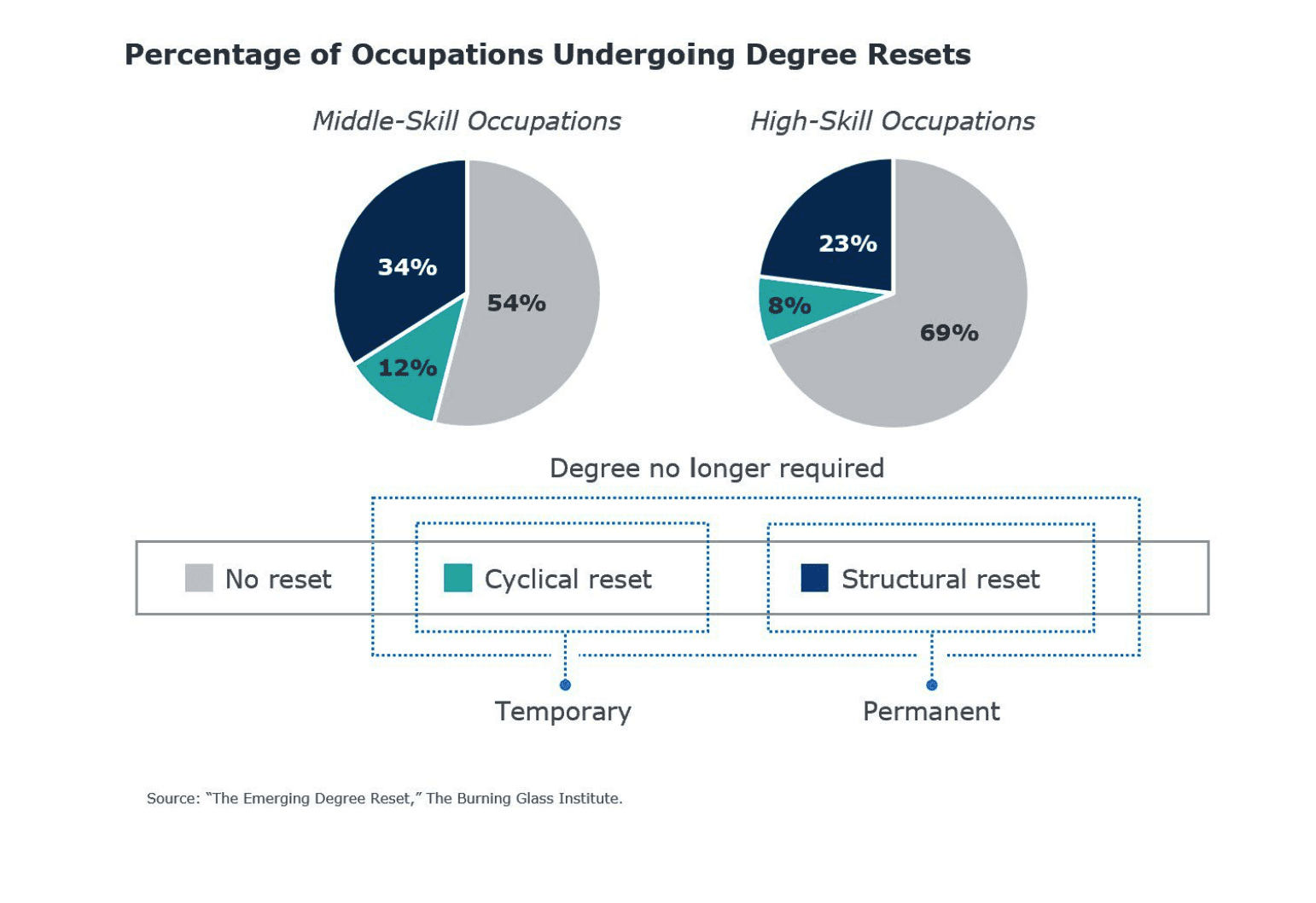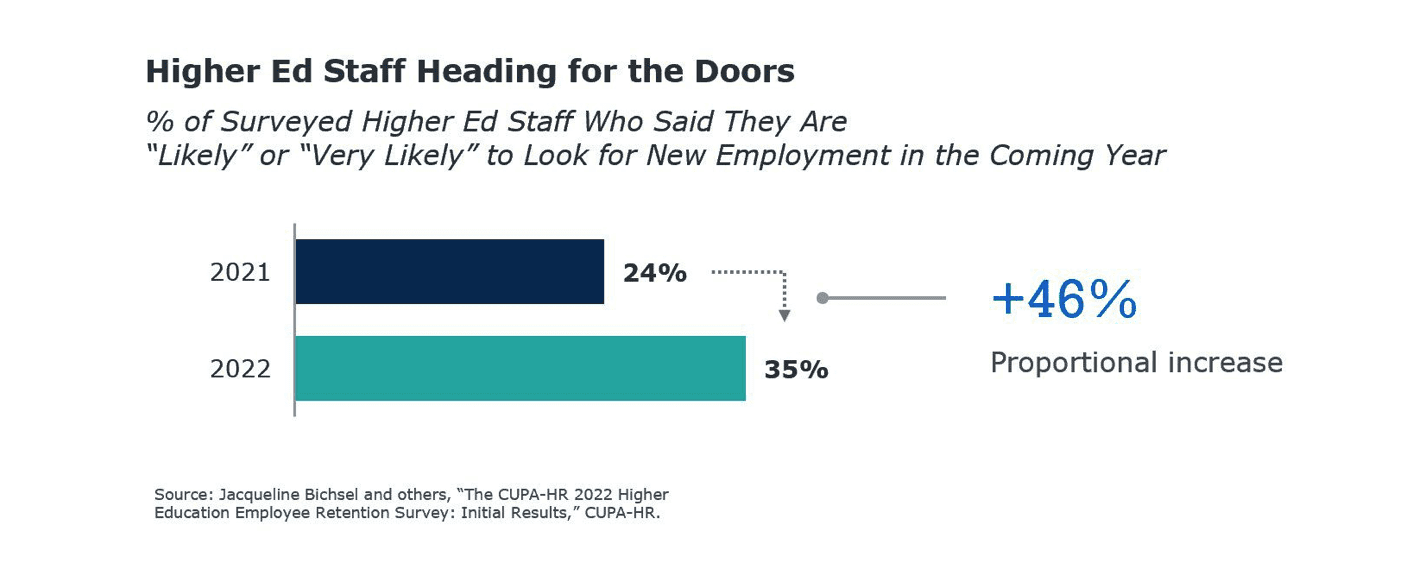Are you prepared for what’s next in the enrollment landscape?
The remarkable convergence of crises our nation has faced since the start of the pandemic has amounted to a stress test for higher education, revealing strengths and vulnerabilities that previously went unnoticed, were underestimated or were perhaps misunderstood. In doing so, it has also brought clarity to the question of which challenges are most likely to define near-term enrollment success or failure. This post covers five corresponding strategic priorities for enrollment leaders (also addressed, in much greater depth, in our new insight paper on the topic).
Strategic priority 1: Understanding decreasing demand for higher education
The 2022 entering class brought welcome news for the nation’s colleges and universities, in the form of a second consecutive year of enrollment growth after a sharp pandemic-driven drop in 2020.
That said, few admissions teams are resting easy. One reason is that the recent rebound comes in the context of a longer-term decline; from 2017 to 2022, four-year public institutions saw a 2.9% decrease in freshman enrollment, and their private counterparts saw that figure drop by 1.8%. Furthermore, many suspect that the recent uptick might just be an anomaly corresponding to pent-up demand from 2020.
Also troubling is the much larger shortfall seen at two-year institutions, whose freshman enrollment dropped 22% between 2017 and 2022. While this may not be the immediate concern of admissions teams at four-year schools (aside from its negative impact on transfer enrollment), some wonder whether this trend might foreshadow similar problems for their institutions.
With the exception of wartime, the United States has never been through a period of declining educational attainment like this.
Michael Hicks
Director, Center for Business and Economic Research, Ball State University Miller College of Business
Responding to this trend of declining enrollment depends on a deeper understanding of its root causes. While admissions community discussion often focuses on the demographic cliff, it appears that there are other important factors at work, including “nonconsumption.” More students are opting out of higher education, for reasons ranging from unaffordability to “degree resets” (the phenomenon of employers no longer requiring prospective hires to have a degree).

Strategic priority 2: Navigating a hostile cultural context
U.S. college and university prestige has been undermined by increasingly widespread negative sentiment regarding higher education among the general public. The percentage of Americans who say college is worth the cost is currently 32%, down from 45% in 2020. And high schoolers are increasingly skeptical, with just half believing that higher education is necessary beyond high school, down from an already low 60% in 2020.
Perceptions of the value of higher education, even among those who advocate going to college, have evolved in troublesome ways. One example is the growing belief that a four-year degree is simply career preparation. Various factors, including the high cost of college, have led students to focus on fields of study they believe are most directly tied to employability and earnings. One of the more striking signs of this is the large drop in humanities enrollment many institutions have seen in the past ten years—40% or more at many schools. While this is not necessarily having a direct negative impact on overall enrollment, it is often outstripping institutions’ ability to adapt, leaving them saddled with programs struggling to demonstrate relevance and vulnerable to competition from non-college providers of job training and certification.
-
>60%
of 18- to 34-year-olds agree that “a four-year college education is not worth the cost because people often graduate without specific job skills and with a large amount of debt to pay off.” Source: 2023 Wall Street Journal/NORC poll
Strategic priority 3: Serving a new kind of student
These changing attitudes toward higher education are just one aspect of a larger transformation in the psychological profile of students, accounts of which have been accumulating in the higher education dailies and in the lay press since the start of the pandemic. Considering these accounts in aggregate, a concerning picture emerges of today’s students. Relative to recent generations of college goers, they are academically underprepared, demonstrate less grit, are more dependent on adults, are undersocialized, and are more likely to disengage (e.g., not attending class or turning in assignments).

What makes this trend especially troubling is the possibility that attributes which we believed to be temporary and reversible effects of the pandemic are actually preexisting conditions. One piece of evidence on this score comes from large-scale survey research examining the mental health profile of young people as compared with older generations. The findings show that younger individuals are at much higher risk of poor mental-health status on a variety of measures, including cognition, resilience, and drive. Most important to all of us who serve students, the researchers attribute these differences not to natural variation across life stages but to true generational differences.
Strategic priority 4: Increasing market share
The negative climate for higher education described above is especially troubling given the enormous challenge enrollment leaders already face in trying to attract a larger share of a shrinking pool of prospective students.
Within this context, it is more important than ever for admissions teams to understand what portion of their enrollment performance is attributable to factors that they can’t control versus ones they can–e.g., local demographic change versus shifts in market share. (EAB can perform this analysis for any four-year institution in the United States, and it is one we routinely undertake on behalf of our partner colleges and universities).
Success in winning market share will increasingly depend on communicating a compelling vision of what makes your institution different and special—your unique DNA, if you will. This can be tough, given that many schools are set up to serve the same types of students in pretty similar ways. Things such as small class sizes, study-abroad opportunities, a friendly community, and a picturesque campus, which feature so prominently in many schools’ pitches, are not going to make you stand out. But what will? The answer will differ for every institution, but effective value differentiators generally meet four main criteria. They are relevant, addressing important student concerns; they are unique, something that your competitors cannot claim to offer (or at least not to your standard); they are broadly applicable, benefitting most students automatically, without them having to take any special steps; and they are provable.
Strategic priority 5: Retooling the admissions office
While the trends I’ve addressed so far are mostly related to external phenomena, several key factors determining enrollment performance are found closer to home—specifically, within admissions teams themselves.
The ongoing challenge for colleges everywhere remains that of understaffing. The nationwide crisis that emerged during the “great resignation” has not gone away; if anything, it is getting worse. And this is happening at a time when admissions office workloads continue to increase, not just on a per-staffer basis, but overall—admissions teams have to engage more applicants, across a growing number of channels, with a greater level of intensity.

Successful teams will cope, in part, by filling open staff positions. But given the difficult labor market and colleges’ typically limited ability to compete on compensation, other approaches will take on outsized importance. Improved personnel management and right-sizing workload should be first priorities. This addresses multiple problems at once, positively impacting staff retention, recruitment, and productivity.
How prepared are you to engage the five strategic priorities?
This post has had a lot more to say about problems than about solutions. I do believe that a clear and comprehensive understanding of the challenges that face us is a precondition for responding effectively. But it is, obviously, just a first step.
I hope this summary of headwinds prompts you to assess how ready your team and your institution are to tackle the challenges. Our insight paper includes five self-tests for enrollment leaders, one for each of the five strategic priorities covered above. The goal is to help you reflect, in a structured way, on your level of preparedness and triage your attention across potential responses.

More Blogs

Demographics shape the enrollment landscape, but strategy determines success

What changed in the graduate lead gen landscape in 2025
